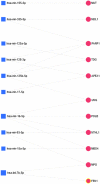Identification of microRNA-mRNA regulatory network associated with oxidative DNA damage in human astrocytes
- PMID: 35570825
- PMCID: PMC9118907
- DOI: 10.1177/17590914221101704
Identification of microRNA-mRNA regulatory network associated with oxidative DNA damage in human astrocytes
Abstract
The high lipid content of the brain, coupled with its heavy oxygen dependence and relatively weak antioxidant system, makes it highly susceptible to oxidative DNA damage that contributes to neurodegeneration. This study is aimed at identifying specific ROS-responsive miRNAs that modulate the expression and activity of the DNA repair proteins in human astrocytes, which could serve as potential biomarkers and lead to the development of targeted therapeutic strategies for neurological diseases. Oxidative DNA damage was established after treatment of human astrocytes with 10μM sodium dichromate for 16 h. Comet assay analysis indicated a significant increase in oxidized guanine lesions. RT-qPCR and ELISA assays confirmed that sodium dichromate reduced the mRNA and protein expression levels of the human base-excision repair enzyme, 8-deoxyguanosine DNA glycosylase 1 (hOGG1). Small RNAseq data were generated on an Ion Torrent™ system and the differentially expressed miRNAs were identified using Partek Flow® software. The biologically significant miRNAs were selected using miRNet 2.0. Oxidative-stress-induced DNA damage was associated with a significant decrease in miRNA expression: 231 downregulated miRNAs and 2 upregulated miRNAs (p < 0.05; >2-fold). In addition to identifying multiple miRNA-mRNA pairs involved in DNA repair processes, this study uncovered a novel miRNA-mRNA pair interaction: miR-1248:OGG1. Inhibition of miR-1248 via the transfection of its inhibitor restored the expression levels of hOGG1. Therefore, targeting the identified microRNA candidates could ameliorate the nuclear DNA damage caused by the brain's exposure to mutagens, reduce the incidence and improve the treatment of cancer and neurodegenerative disorders.
Keywords: DNA repair; astrocytes; microRNA; oxidative stress.
Conflict of interest statement
Figures









Similar articles
-
Activity of OGG1 variants in the repair of pro-oxidant-induced 8-oxo-2'-deoxyguanosine.DNA Repair (Amst). 2006 Nov 8;5(11):1337-45. doi: 10.1016/j.dnarep.2006.06.001. Epub 2006 Jul 24. DNA Repair (Amst). 2006. PMID: 16861056
-
Oxidative DNA damage and its repair in rat spleen following subchronic exposure to aniline.Toxicol Appl Pharmacol. 2008 Dec 1;233(2):247-53. doi: 10.1016/j.taap.2008.08.010. Epub 2008 Aug 22. Toxicol Appl Pharmacol. 2008. PMID: 18793663 Free PMC article.
-
Defective Base Excision Repair of Oxidative DNA Damage in Vascular Smooth Muscle Cells Promotes Atherosclerosis.Circulation. 2018 Oct 2;138(14):1446-1462. doi: 10.1161/CIRCULATIONAHA.117.033249. Circulation. 2018. PMID: 29643057 Free PMC article.
-
Regulation of intracellular localization of human MTH1, OGG1, and MYH proteins for repair of oxidative DNA damage.Prog Nucleic Acid Res Mol Biol. 2001;68:75-94. doi: 10.1016/s0079-6603(01)68091-7. Prog Nucleic Acid Res Mol Biol. 2001. PMID: 11554314 Review.
-
Repair of 8-oxo-7,8-dihydroguanine in prokaryotic and eukaryotic cells: Properties and biological roles of the Fpg and OGG1 DNA N-glycosylases.Free Radic Biol Med. 2017 Jun;107:179-201. doi: 10.1016/j.freeradbiomed.2016.11.042. Epub 2016 Nov 27. Free Radic Biol Med. 2017. PMID: 27903453 Review.
Cited by
-
Competing endogenous RNAs in human astrocytes: crosstalk and interacting networks in response to lipotoxicity.Front Neurosci. 2023 Nov 13;17:1195840. doi: 10.3389/fnins.2023.1195840. eCollection 2023. Front Neurosci. 2023. PMID: 38027526 Free PMC article.
References
-
- Borgesius N. Z., de Waard M. C., van der Pluijm I., Omrani A., Zondag G. C. M., van der Horst G. T. J., Melton D. W., Hoeijmakers J. H. J., Jaarsma D., Elgersma Y. (2011). Accelerated age-related cognitive decline and neurodegeneration, caused by deficient DNA repair. Journal of Neuroscience, 31(35), 12543–12553. 10.1523/JNEUROSCI.1589-11.2011. - DOI - PMC - PubMed
Publication types
MeSH terms
Substances
Grants and funding
LinkOut - more resources
Full Text Sources
Research Materials
